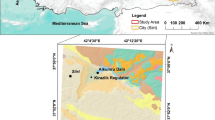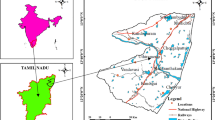Abstract
Seismic soil liquefaction is one of the most relevant phenomena of ground failure that may induce disastrous consequences on structures, infrastructures and the environment. This article presents the first probabilistic zonation for liquefaction hazard at national scale, carried out with reference to Italy. Macrozonation is the geospatial identification of areas in a national territory that, in case of an earthquake, may be affected by phenomena associated to soil liquefaction by using a probabilistic approach. Zonation of a large territory for earthquake-induced liquefaction hazard seems to be, at least at a first glance, an unachievable goal, since liquefaction occurs at a very local scale. In this study, the strategy for macrozoning consists in combining and processing geospatial predictors, which represent both ground susceptibility to liquefaction and expected seismic loading. A database was built for the Italian territory including the explanatory variables adopted as proxies for soil density, degree of saturation and ground motion intensity. This database represents the starting point for the application of a geospatial methodology based on logistic regression for assessing the liquefaction hazard in Italy. The outcomes are macrozonation charts computed for three return periods (i.e. 475, 975 and 2475 years) with a spatial resolution on the order of 500 m. The mapping was validated by superimposing historical liquefaction and then compared with the coarser charts recently delivered for Europe. Despite their intrinsic limitations, national scale maps of liquefaction hazard may support decision-makers, civil protection agencies, insurance and re-insurance companies to fund zonation projects at regional or even at urban/suburban scale.










Similar content being viewed by others
References
Albarello D (2012) Design earthquake from site-oriented macroseismic hazard estimates. Boll Geofis Teor Appl 53(1):7–17. https://doi.org/10.4430/bgta0035
Bozzoni F, Bonì R, Conca D, Lai CG, Zuccolo E, Meisina C (2021a) Megazonation of earthquake-induced soil liquefaction hazard in continental Europe. Bull Earthq Eng 19:4059–4082. https://doi.org/10.1007/s10518-020-01008-6
Bozzoni F, Bonì R, Conca D, Meisina C, Lai CG, Zuccolo E (2021b) A geospatial approach for mapping the earthquake-induced liquefaction risk at European scale. Geosciences 11:32. https://doi.org/10.3390/geosciences11010032
Bozzoni F, Cantoni A, De Marco MC, Lai CG (2021c) ECLiq: European interactive catalogue of earthquake-induced soil liquefaction phenomena. Bull Earthq Eng 19:4719–4744. https://doi.org/10.1007/s10518-021-01162-5
CEN (2004) Eurocode 8. Design of structures for earthquake resistance, Part 1: general rules, seismic actions and rules for buildings, Pr-EN1998-1. European Committee for Standardization (CEN), Brussels
Centro Studi (2014) The earthquake costs in Italy (I costi dei terremoti in Italia). Roma: Consiglio nazionale ingegneri. http://cache.b.centrostudicni.it/images/pubblicazioni/ricerche/cr470_costi_terremoto_59a5d.pdf. Accessed 7 Sept 2017 (in Italian)
Chen R, Harmsen S (2012) Probabilistic ground motion calculations and implementation of PGA scaling by magnitude for assessing liquefaction hazard. Technical Document 2012–1, Seismic Hazard Zonation Program
Cornell CA, Luco N (2001) Ground motion intensity measures for structural performance assessment at near-fault sites. In: Proceedings U.S.-Japan joint workshop and third grantees meeting, U.S.-Japan Coop. Res. on Urban EQ. Disaster Mit. Seattle, Aug. 15–16 2001, Univ. of Washington
Cubrinovski M (2019) Some important considerations in the engineering assessment of soil liquefaction. NZ Geomechanics News, Issue 97. https://www.nzgs.org/library/some-important-considerations-in-the-engineering-assessment-of-soil-liquefaction/
Fawcett T (2005) An introduction to ROC analysis. Pattern Recognit Lett 27:861–874. https://doi.org/10.1016/j.patrec.2005.10.010
Forte G, Chioccarelli E, De Falco M, Cito P, Santo A, Iervolino I (2019) Seismic soil classification of Italy based on surface geology and shear-wave velocity measurements. Soil Dyn Earthq Eng 122:79–93. https://doi.org/10.1016/j.soildyn.2019.04.002
Foster KM, Bradley BA, McGann CR, Wotherspoon LM (2019) A VS30 map for New Zealand based on geologic and terrain proxy variables and field measurements. Earthq Spectra 35(4):1865–1897. https://doi.org/10.1193/121118EQS281M
Geyin M, Baird AJ, Maurer BW (2020) Field assessment of liquefaction prediction models based on geotechnical versus geospatial data, with lessons for each. Earthq Spectra 36(3):1386–1411. https://doi.org/10.1177/8755293019899951
Green RA, Bommer JJ (2019) What is the smallest earthquake magnitude that needs to be considered in assessing liquefaction hazard? Earthq Spectra 35(3):1441–1464
ICMS-LIQ (2018) Microzonazione sismica. Linee guida per la gestione del territorio in aree interessate da liquefazioni (LQ). Versione 1.0. Commissione tecnica per la microzonazione sismica. Roma, 2018. The Enghish version is: Technical Commission on Seismic Microzonation, Land Use Guidelines for Areas Affected by Liquefaction (LQ)”, version 1.0, Rome, 2018, available at the following link: https://www.centromicrozonazionesismica.it/
Jarvis A, Reuter HI, Nelson A, Guevara E (2008) Hole-filled SRTM for the globe Version 4, available from the CGIAR-CSI SRTM 90m Database: http://srtm.csi.cgiar.org
Luco N, Cornell CA (2007) Structure-specific scalar intensity measures for near-source and ordinary earthquake ground motions. Earth Spectra 23(2):357–392
Meletti C, Galadini F, Valensise G, Stucchi M, Basili R, Barba S, Vannucci G, Boschi E (2004) Zonazione sismogenetica ZS9. Istituto Nazionale di Geofisica e Vulcanologia (INGV). https://doi.org/10.13127/sh/zs9
Meletti C, Marzocchi W, D’Amico V, Lanzano G, Luzi L, Martinelli F, Pace B, Rovida A, Taroni M, Visini F, Group MW. The new Italian seismic hazard model (MPS19). Ann. Geophys.; 64(1): SE112. https://www.annalsofgeophysics.eu/index.php/annals/article/view/8579
Moore ID, Gessler PE, Nielsen GA, Petersen GA (1993) Terrain attributes: estimation methods and scale effects. In: Jakeman AJ (ed) Modeling change in environmental systems. M.B. Beck and M. McAleer Wiley, London, pp 189–214
Mori F, Mendicelli A, Moscatelli M, Romagnoli G, Peronace E, Naso G (2020) A new Vs30 map for Italy based on the seismic microzonation dataset. Eng Geol 275:105745. https://doi.org/10.1016/j.enggeo.2020.105745
NASEM (2016) National academies of sciences, engineering, and medicine. State of the art and practice in the assessment of earth-quake-induced soil liquefaction and its consequences. The National Academies Press, Washington, DC, https://doi.org/10.17226/23474
NTC (2018) Norme tecniche per le Costruzioni, D.M. 17.1.2018 (Italian Building Code)
Padgett JE, Nielson BG, DesRoches R (2008) Selection of optimal intensity measures in probabilistic seismic demand models of highway bridge portfolios. Earth Eng Struct Dyn 37(5):711–725
Rashidian V, Baise L (2020) Regional efficacy of a global geospatial liquefaction model. Eng Geol 2020:272. https://doi.org/10.1016/j.enggeo.2020.105644
Spallarossa D, Barani S (2007) Disaggregazione della pericolosità sismica in termini di M-R-ε, DPC- INGV S1 Project: http://esse1.mi.ingv.it/d14.html
Stucchi M, Meletti C, Montaldo V, Crowley H, Calvi GM, Boschi E (2011) Seismic hazard assessment (2003–2009) for the Italian building code. Bull Seismol Soc Am 101(4):1885–1911. https://doi.org/10.1785/0120100130
Wang X, Shafieezadeh A, Ye A (2018) Optimal intensity measures for probabilistic seismic demand modeling of extended pile-shaft-supported bridges in liquefied and laterally spreading ground. Bullet Earthq Eng 16:229–257. https://doi.org/10.1007/s10518-017-0199-2
Yilmaz C, Silva V, Weatherill G (2021) Probabilistic framework for regional loss assessment due to earthquake-induced liquefaction including epistemic uncertainty. Soil Dyn Earthq Eng. https://doi.org/10.1016/j.soildyn.2020.106493
Youd TL, Idriss IM, Andrus RD, Arango I, Castro G, Christian JT, Dobry R, Finn WDL, Harder LF, Hynes ME, Ishihara K, Koester JP, Liao SSC, Marcuson WF, Martin GR, Mitchell JK, Moriwaki Y, Power MS, Robertson PK, Seed RB, Stokoe KH (2001) Liquefaction resistance of soils: summary report from the 1996. NCEER and 1998 NCEER/NSF workshops on the evaluation of liquefaction resistance of soils. J Geotech Geoenviron Eng 127:817–833
Zhu J, Baise L, Thompson E (2017) An updated geospatial liquefaction model for global application. Bull Seismol Soc Am 107(3):1365–1385. https://doi.org/10.1785/0120160198
Zhu J, Daley D, Baise L, Thompson E, Wald D, Knudsen K (2015) A geospatial liquefaction model for rapid response and loss estimation. Earthq Spectra 31(3):1813–1837. https://doi.org/10.1193/121912EQS353M
Funding
The authors declare that no funds, grants, or other support were received during the preparation of this manuscript.
Author information
Authors and Affiliations
Contributions
All authors contributed to the study conception. Francesca Bozzoni defined the methodology. Material preparation, data collection and analysis were performed by Alessia Furiosi and Francesca Bozzoni. The first draft of the manuscript was written by Francesca Bozzoni and all authors commented on previous versions of the manuscript. All authors read and approved the final manuscript.
Corresponding author
Ethics declarations
Conflict of interest
The authors have no relevant financial or non-financial interests to disclose.
Additional information
Publisher's Note
Springer Nature remains neutral with regard to jurisdictional claims in published maps and institutional affiliations.
Rights and permissions
Springer Nature or its licensor holds exclusive rights to this article under a publishing agreement with the author(s) or other rightsholder(s); author self-archiving of the accepted manuscript version of this article is solely governed by the terms of such publishing agreement and applicable law.
About this article
Cite this article
Bozzoni, F., Furiosi, A. & Lai, C.G. Probabilistic assessment of the earthquake-induced soil liquefaction hazard at national scale: macrozonation of the Italian territory. Nat Hazards 115, 2237–2255 (2023). https://doi.org/10.1007/s11069-022-05636-w
Received:
Accepted:
Published:
Issue Date:
DOI: https://doi.org/10.1007/s11069-022-05636-w




